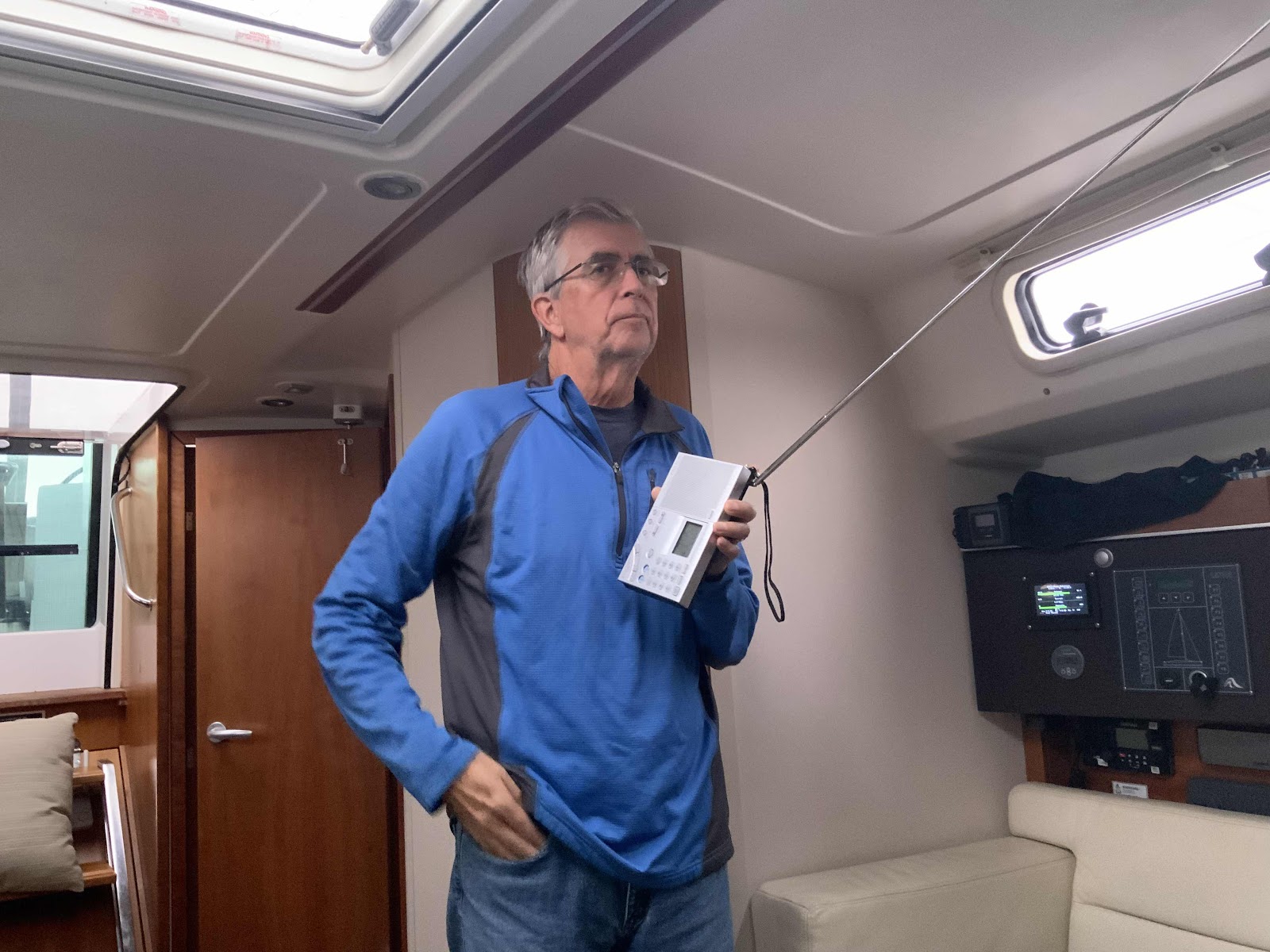Our measly one-to-two bars of cell service was not adequate for receiving Chris Parker’s weather forecast this morning. So George texted our friend, Jean, and asked if she would listen in and report to us any advice on leaving the Chesapeake and rounding Cape Hatteras in the near future. Not only did she listen in but she recorded it and sent the recording to us. In the meantime, George tried tuning into the broadcast using our portable SSB radio. Before cell service and the internet were widely available, SSB radio was how cruisers received their weather broadcasts and communicated with each other when they were not close enough to talk on the VHF radio. Many boats have a built-in SSB radio system. They are complicated and expensive so we opted not to add one to Breeze On. We instead chose a satellite phone for emergencies as well as the portable SSB radio. There are times, like this morning, when we are at a disadvantage by not having a built-in SSB radio.

Holding our portable SSB radio just so in order to hear the weather forecast. If it is moved even an inch in the wrong direction the broadcast is lost. If the boat is swinging at anchor, the radio has to be moved to compensate. This is how we received—or not—our weather forecasts every morning our first few years in the Bahamas.

Topping up the fuel tank. The jerry cans are all lined up waiting to be filled. They are now tied up at various places along the rail. George is wearing a “marriage saver” headset—a wireless microphone/headphone set. We use them when anchoring and docking so we don’t have to yell at each other.
The weather forecast for this week as been uncertain, to put it mildly. Our own weather apps showed a trough sitting just offshore. That did not inspire confidence in making the passage from the Chesapeake to Beaufort, NC. However, Chris said the trough would not cause any problems for sailors and the passage should be good as long as we were in port by Wednesday afternoon. So, instead of heading to Cape Charles as planned, we are continuing on to Beaufort. If we chose not to take advantage of this weather window it would be another week before we had another opportunity. Sailors have to be flexible!
Before leaving Fishing Bay this morning we went to the marina to top off the fuel tank and filled five additional jerry cans with diesel. For reasons we don’t yet understand we burned through much more diesel than normal since leaving home. We usually average .6-.7 gallons per hour when motoring at 1800 rpm. So far this trip we have been burning 1 gallon per hour—even though we kept the engine set at the usual 1800 rpm. Is it the additional wind resistance of the dinghy on the bow? Or the added weight of the canned food on board? We will have to do some more research to figure out this latest mystery.
Our trip to Beaufort, NC is about 250 nautical miles. We hope to make it to Beaufort by early Wednesday morning. We expect to be motor-sailing most of the way, hence all of the extra fuel.
On another note, the batteries are still charging as they should.
Holding our portable SSB radio just so in order to hear the weather forecast. If it is moved even an inch in the wrong direction the broadcast is lost. If the boat is swinging at anchor, the radio has to be moved to compensate. This is how we received—or not—our weather forecasts every morning our first few years in the Bahamas.
Topping up the fuel tank. The jerry cans are all lined up waiting to be filled. They are now tied up at various places along the rail. George is wearing a “marriage saver” headset—a wireless microphone/headphone set. We use them when anchoring and docking so we don’t have to yell at each other.
I’m in Florida and we are following your progress on Leslie’s world atlas. An adventure a minute—safe journey my friends.
ReplyDeleteThank you! Yes we do have a lot of adventures. I hope things are going well for you in FL.
Delete